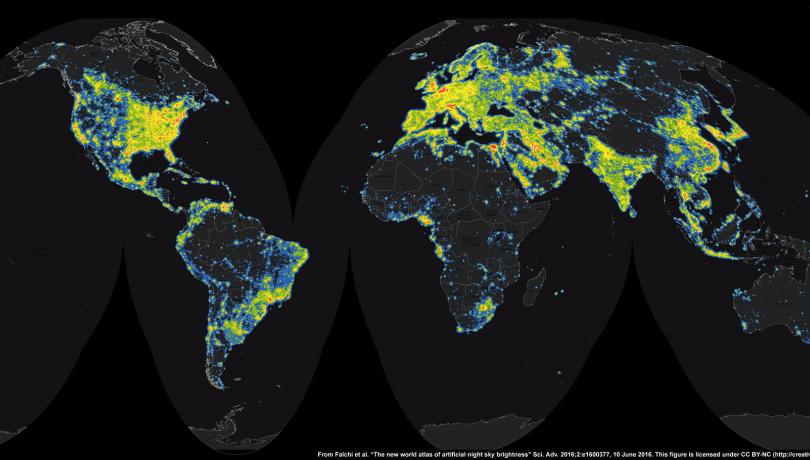The ICM-CSIC is co-author of this new publication in the "Science for Public Policy" collection, a strategic project promoted by the organisation to define policies based on scientific evidence.

The Institut de Ciències del Mar (ICM-CSIC), in collaboration with the Instituto de Astrofísica de Andalucía (IAA-CSIC) and the Museo Nacional de Ciencias Naturales (MNCN), has produced one of the three new issues of the "Science for Policy" collection. This issue, devoted to light pollution, sets out the challenge of tackling the environmental problem caused by the uncontrolled proliferation of artificial light on our planet.
With this series of reports, the Consejo Superior de Investigaciones Científicas (CSIC) seeks to serve as a bridge between research centres and policy makers to contribute to the definition of public policies based on scientific evidence. "This programme aims to become a mechanism for public decision-makers at all levels of government to make more effective decisions based on scientific knowledge," stressed the president of the CSIC, Eloísa del Pino, at the presentation of these new reports, which took place last Monday at the CSIC headquarters.
The report "Light Pollution: The Dangers of an Increasingly Illuminated World", which focuses on one of the most pressing environmental threats of this century, highlights the impact that light pollution has on health, ecosystems, cultural heritage and our knowledge of the cosmos, among many other aspects.
"Light pollution is an imminent and global risk to which we must respond in the same way as we face other threats such as waste management, drought or ocean protection", explained Alicia Pelegrina, member of the IAA-CSIC's Technical Office of Sky Quality and co-author of the report, who presented it to political decision-makers, communication professionals and members of the scientific community.
Light pollution is defined as the alteration of the natural darkness at night caused by artificial light. It is a growing phenomenon. Every year, the global illuminated area and the intensity of artificial brightness in the night sky increases by about 2.2 %, and in the last 25 years, this increase has been 50 %.
Faced with this scenario, the report calls for urgent, multidimensional and multisectoral intervention, providing recommendations for action and decisions for policy makers and local authorities, as well as for the private sector, the scientific community and society in general.
A multidisciplinary approach
To prepare the report, an interdisciplinary scientific team, composed of experts in environment, biological ecosystems and astrophysical research, has compiled and synthesised the current knowledge on light pollution. They have focused especially on the areas where the CSIC is leading research projects to assess the effects of this environmental problem.
In particular, the report highlights the CSIC's leadership in monitoring sky brightness generated by artificial lights and its significant impact, especially on astronomical observations. According to José Manuel Vilchez, researcher at the IAA-CSIC and co-author of the report, "the Sky Quality Technical Office of the IAA-CSIC is at the forefront in the evaluation of light pollution in our cities using images obtained from the International Space Station".
The report highlights those studies aimed at assessing the effect of this type of pollution on natural ecosystems and the species that inhabit them.
"This is the case, for example, of shearwaters, a species of seabird that is attracted by artificial lights on our coasts, causing massive mortality," explains Airam Rodriguez, researcher at the MNCN-CSIC and co-author of the report.
"As a result of light pollution, many species have modified their activity patterns and daily rhythms, which can become a real ecological trap that affects our fisheries policies, for example," concludes Francisco José Ramirez, researcher at the ICM-CSIC and co-author of the report.
Finally, the report highlights the potential of the research carried out at the CSIC to address the effects of light pollution on human health, especially as a possible risk factor in some types of cancer and metabolic diseases.
A silent and social threat
The report also warns about a crucial aspect of this environmental threat: the social perception of artificial light. Culturally, artificial light is associated with well-being, beauty, advanced societies, status and security. This perception leads to excessive lighting in towns and cities being perceived not as a threat, but as a clear indicator of well-being and progress.
Proof of the importance of the social factor associated with this problem is the study carried out by the CSIC in 2023, which revealed how the major festivities of various human societies influence light pollution patterns on a global scale. This phenomenon is especially observed in religious festivities that involve excessive use of artificial lights at night.
The report warns that current regulations are insufficient, as there are no legally established maximum limits for light pollution. Furthermore, it points out that effective regulation lacks coordination at local, regional and international levels, and is not based on sufficient scientific evidence.
The solution is in our hands
The report is conceived as a decision-making tool based on scientific evidence, and therefore presents a series of clear and concise final recommendations addressed to both public administrations and the private sector.
Among other recommendations, it includes measures such as increasing legislative efforts to regulate artificial light as a pollutant; establishing a roadmap to coordinate the efforts of all administrations; and defining protected areas considering the wide dispersion of light as a pollutant.
In addition to these general measures, there are more specific recommendations, such as the implementation of smart-lighting techniques to adjust the intensity and operating hours of lights according to the specific needs of each site; avoiding emission angles greater than 70º and giving priority to warm light, such as that generated by sodium lamps or amber LEDs, among other recommended actions. For the private sector, it is recommended to explore marketing strategies that do not rely exclusively on artificial light; to eliminate highly polluting white LEDs from the market; and to collaborate with the public sector to create a sustainable lighting label.